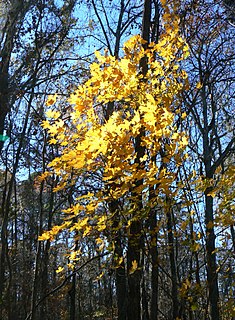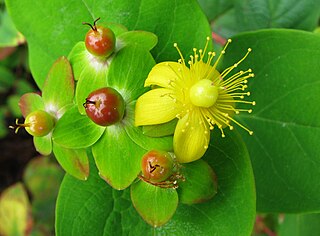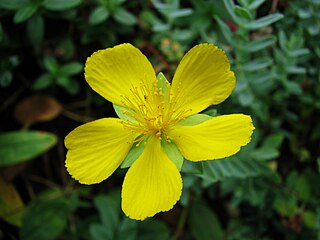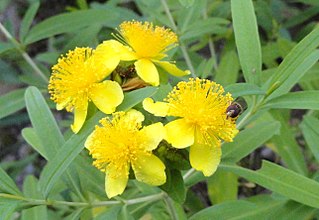
Hypericum perforatum, known as perforate St John's-wort, common Saint John's wort and simply St John's wort, is a flowering plant in the family Hypericaceae. St. John's wort has been used in alternative medicine as a likely effective aid in treating mild to moderate depression and related symptoms such as anxiety or insomnia. Study results on the effectiveness of Hypericum perforatum for depression have been mixed. Since it causes drug interactions, it might not be an appropriate choice for many people, particularly those who take other medications. The primary phytochemical constituents of St John's wort are hyperforin and hypericin. Hypericum perforatum is native to parts of Europe, Asia, and northern Africa, but has spread and is considered an invasive species in some parts of the world. The plant is poisonous to livestock.

Hypericum is a genus of flowering plants in the family Hypericaceae. The genus has a nearly worldwide distribution, missing only from tropical lowlands, deserts and polar regions. Many Hypericum species are regarded as invasive species and noxious weeds. All members of the genus may be referred to as St. John's wort, and some are known as goatweed. The white or pink flowered marsh St. John's worts of North American and eastern Asia are now separated into the genus Triadenum.

Hypericum calycinum is a species of prostrate or low-growing shrub in the flowering plant family Hypericaceae. Widely cultivated for its large yellow flowers, its names as a garden plant include Rose-of-Sharon in Britain and Australia, and Aaron's beard, great St-John's wort, creeping St. John's wort and Jerusalem star. Grown in Mediterranean climates, widely spread in the Strandja Mountains along the Bulgarian and Turkish Black Sea coast, and also in Flanders in Belgium.

Hyperforin is a phytochemical produced by some of the members of the plant genus Hypericum, notably Hypericum perforatum. Hyperforin may be involved in the pharmacological effects of St. John's wort, specifically in its antidepressant effects.

Acer floridanum, commonly known as the Florida maple and occasionally as the southern sugar maple or hammock maple, is a tree that occurs in mesic and usually calcareous woodlands of the Atlantic and Gulf coastal plain in the United States, from southeastern Virginia in the north, south to central Florida, and west to Oklahoma and Texas and also common in south Illinois and Missouri

Hypericum androsaemum, also referred to as Tutsan, Shrubby St. John's Wort, or sweet-amber, is a flowering plant in the family Hypericaceae. It is a perennial shrub reaching up to 70 cm in height, native to open woods and hillsides in Eurasia.

Hypericum olympicum, commonly known as the Mount Olympus St. John's wort, is a species of flowering plant in the family Hypericaceae found in the Balkans and Turkey and introduced to western Europe. It has been widely cultivated for centuries because of its large, showy flowers, which are far larger than those of most other species in Hypericum.

Euspilapteryx auroguttella is a moth of the family Gracillariidae. It is known from all of Europe.

Hypericum cumulicola is a rare species of flowering plant in the family Hypericaceae known by the common name highlands scrub hypericum, or highlands scrub St. John's wort. It is endemic to Florida, where it is threatened by habitat loss and degradation. It is a federally listed endangered species of the United States.

Hypericum hypericoides, commonly called St. Andrew's cross, is a species of flowering plant in the St. John's wort family, Hypericaceae. It is native to the Southeastern United States, Mexico, Central America, and the Caribbean. Its preferred habitat is dry woods on acidic soil. It is a small shrub or shrublet that produces yellow flowers with four petals.

Hypericum boreale, also known as northern St. John's-wort, is a short-lived perennial species of flowering plant in the family Hypericaceae, section Trigynobrathys.
Hypericum sinaicum is a perennial herb in the genus Hypericum, in the section Adenosepalum.

Hypericum kalmianum, commonly called Kalm's St. Johns wort or Kalm's St. Johnswort, is a flowering plant in the St. John's wort family Hypericaceae. It is native to the Great Lakes region in the northern United States and southern Canada. Hypericum kalmianum was named after its discoverer, Swedish botanist Pehr Kalm (1715-1779).

Hypericum hookerianum, or Hooker's St. John's Wort, is a perennial shrub in the flowering plant family Hypericaceae native to eastern and southern Asia. The specific name hookerianum is named for William Jackson Hooker.

Hypericum sect. Adenosepalum is one of 36 sections in the genus Hypericum. Its type species is Hypericum montanum.

Hypericum tenuifolium, known as Atlantic St. John's-wort and sandhill St. John's-wort, is a species of flowering plant in the St. John's wort family, Hypericaceae. It is native to the Southeastern United States.

Hypericum reflexum is a species of plant in the St. Johns wort family, Hypericaceae, endemic to the Canary Islands. It is a small shrub up to 1 m in height with opposite, sessile leaves up to 25 mm (0.98 in) long and 12 mm (0.47 in) across. The flowerheads produce 5–40 bright yellow flowers with five petals each.
Hypericum sect. Sampsonia is a small section of plants in the genus Hypericum. It comprises only two species, both endemic to eastern Asia: Hypericum sampsonii and Hypericum assamicum.

Hypericum huber-morathii is a flowering plant in the family Hypericaceae, section Adenosepalum, and the type species of the Hypericum huber-morathii group.















